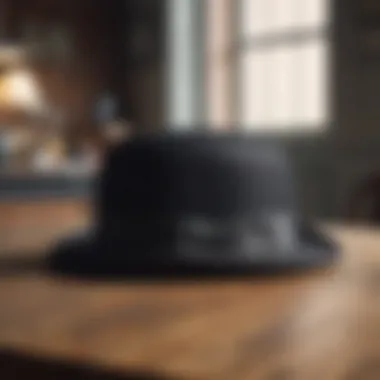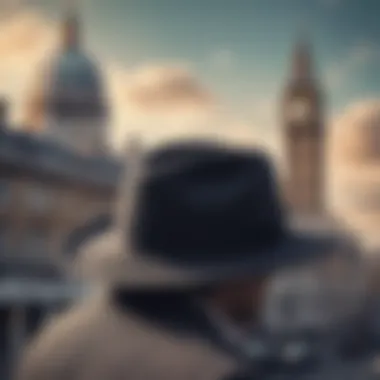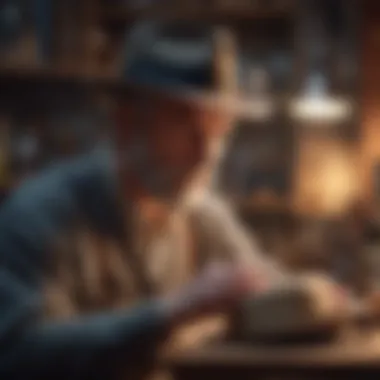The Evolution and Influence of British Style Hats


Intro
British style hats are more than mere accessories; they form a rich tapestry that stretches across centuries of history, culture, and fashion innovation. These hats, from the classic bowler to the sleek fedora, are mirrors reflecting the societal norms and artistic movements of their times. Each design encapsulates a story—be it the industrial revolution that brought forth the bowler or the sophisticated social gatherings that made the fedora a staple.
Whether you’re a fashion enthusiast intrigued by the nuances of headwear or a casual shopper looking for that perfect accessory, understanding the evolution of these hats unveils a world where style, craftsmanship, and cultural identity intertwine. The artistry involved in creating these hats speaks to a legacy of workmanship that defines not just British fashion but influences global trends.
In this article, we will journey through the various types of British hats, exploring their origins, characteristics, and the contemporary trends shaping their resurgence today. It’s essential to recognize that these hats contribute significantly to our modern wardrobes, providing a bridge between historical elegance and contemporary flair.
Join us as we dissect the fashion importance of British hats while offering insights into how to incorporate them thoughtfully into daily ensembles. But before we dive deeper, let’s take a look at the current fashion trends surrounding these iconic pieces.
Prologue to British Style Hats
The world of fashion is a vibrant tapestry woven with threads of tradition, culture, and history. British style hats hold a significant place in this intricate fabric, not merely as accessories but as symbols of identity and expression. This section aims to shed light on the importance of British style hats in the broader context of fashion, examining their evolution, their role in society, and how they resonate with contemporary culture.
Understanding the Cultural Landscape
British hats are steeped in a rich cultural heritage that speaks volumes about the society they originate from. From the stately bowler to the more relaxed fedora, each type of hat reflects specific societal norms, traditions, and even the occupational status of its wearer.
In the bustling streets of London, hats have been used to communicate various messages. For instance, the bowler hat, often associated with the upper middle class, symbolizes a certain level of sophistication and professionalism. In contrast, hats like the flat cap signify a more working-class background, representing practicality and rootedness. By examining these distinctions, one can garner a deeper understanding of how fashion—especially headwear—serves as a narrative device, telling stories of tradition and lifestyle.
The cultural significance of these hats transcends mere fashion. They are often worn during significant events, illustrating their relevance in ceremonial occasions. Whether it’s a wedding, a formal gathering, or even a political event, the choice of hat can convey a multitude of meanings, adding layers to social interactions. British style hats thus emerge as key players in the dance between fashion and culture.
Defining British Style
What constitutes 'British style' can be a contentious issue, influenced by countless factors including history, geography, and social class. To define it is to acknowledge the fluidity of identity inherent within British fashion. British style is, at its core, a blend of classic elegance and quirky individuality. It allows for personal expression while adhering to a certain etiquette, particularly in its approach to headwear.
Hats exemplify this duality perfectly. The sophistication of a top hat contrasts sharply with the casual feel of a straw hat, yet they both coexist within the British style canon. This ability to unify disparate elements makes British fashion remarkably eclectic.
Furthermore, British style is not stagnant; it evolves, absorbs influences from around the globe, and adjusts to modern sensibilities. The recent resurgence of vintage hats alongside contemporary fashion underlines an important trend—there’s nostalgia combined with innovation at play.
Ultimately, the evolution of British style hats serves as a microcosm of broader fashion trends while providing insight into the cultural and social dynamics of the time. Thus, understanding British style hats gives one a window into the complexities of identity, tradition, and modernity in British culture.
"Hats are not just accessories; they narrate stories of civilization, from craftsmanship to cultural rituals."
Through this exploration of British style hats, we journey through layers of meaning, craftsmanship, and societal influences, setting the stage for a fuller understanding of what these hats represent in both historical and contemporary contexts.
Historical Context
Understanding the historical context of British style hats is like peeling back the layers of an onion; each layer reveals the influence of societal structures, cultural shifts, and fashion evolution over decades. Hats are not just accessories. They are artifacts that tell stories of the times and people they represent. The rich tapestry of British hat history serves as a conduit through which we can examine the interplay between identity, class, and tradition in British society.
The Birth of Distinct Styles
The emergence of distinct styles of hats in Britain is closely tied to the social dynamics and historical events that shaped the nation. As the industrial revolution kicked into gear in the 18th and 19th centuries, the urban landscape began to change. Workers, factory overseers, and the burgeoning middle class adopted styles that conveyed their status and identity.
- Bowler Hat: Originally created for the working class, the bowler hat soon became a staple for London businessmen. Its round shape and hard crown represented stability and a shift towards a more assertive form of masculinity.
- Top Hat: This iconic headpiece reflected the decadence of the upper classes. It became synonymous with formality, especially in the context of social gatherings and political discourse.
- Trilby: Emerging later in the 20th century, the trilby was adopted by the bohemian crowd, signifying a departure from the formality of earlier styles.
These distinct styles evolved alongside social changes. Each design seemed to embody a particular ethos of its time, serving as a barometer of the collective psyche.
Influence of Social Class and Occupation
In British culture, the role of hats as indicators of social class cannot be overstated. Various styles were often correlated with occupation, effectively dictating who wore what and when.
Working-class individuals primarily sported practical and unadorned hats, like caps, designed primarily for utility. In contrast, members of the upper classes adorned themselves with elaborate designs, materials, and embellishments, showcasing not just wealth but also their social position.
- Occupation Influence:


- The tradesman wore simple yet sturdy hats made of wool, enhancing their image as reliable and hard-working.
- The gentleman donned a fedora or a top hat for outings, showcasing sophistication and a cultured background.
- Even the military hats, like the peaked cap, communicated authority and discipline, reinforcing hierarchical structure within society.
The statement "A hat is a silent ambassador of one's station in life," rings truer in the British context, where what is on one’s head says as much about them as their words or actions.
Contemporary fashion continues to salute these historical touchstones. Despite the relaxation of strict social norms, certain styles remain connectors to broader cultural narratives about identity and class. Hats today still prompt conversations about who we are and where we come from, making their historical evolution relevant in understanding modern fashion.
By examining the significance of historical context in the realm of British hats, we gain valuable insight not just into a fashion accessory, but into the societal values and transformations that have shaped contemporary British culture.
Types of British Style Hats
British style hats are not just accessories; they embody culture, class, and a rich history that stretches back generations. Each type of hat is steeped in its own narrative, reflecting societal norms and changes in fashion over time. Understanding these types allows enthusiasts and newcomers alike to appreciate the significance behind the choices people make when donning these pieces. Wearing a specific style can convey messages about identity, sophistication, and even cultural stands. In this section, we'll explore various hat styles, focusing on their unique features, historical significance, and why they continue to resonate in modern fashion.
The Bowler Hat
Origins and Development
The bowler hat, known for its distinctive rounded crown, has roots that trace back to mid-19th century England. Designed by Thomas Bowler, its creation aimed to provide a more durable option than the top hat, often worn in the countryside. This hat became a staple for gentry but also permeated various social classes. What’s interesting is how it evolved from a rough working class staple to a symbol of the upper crust in cities. Its strength and shape made it a practical but stylish choice during those times, setting the stage for its lasting popularity.
Key Characteristics
When talking about key characteristics of the bowler hat, one might point out its hard felt, moderate size, and the narrow brims that curve slightly upward. It’s durable, making it a favorite for those needing something for a variety of occasions, from business meetings to social gatherings. This blend of form and function is why it remains a significant headwear choice. You can wear it almost anywhere and feel confident, yet it doesn’t overshadow the wearer’s outfit.
Iconic Wearers
The bowler hat has adorned the heads of many notable figures throughout history, enhancing its allure. Think of Winston Churchill and Charlie Chaplin. These personalities didn’t just wear the bowler; they made it a statement. The hat's association with strength and pragmatism creates a powerful image that’s hard to forget. This iconic status undoubtedly contributes to its ongoing appeal in modern fashion scenes.
The Fedora
Evolution Through Decades
Emerging in the late 19th century, the fedora underwent multiple transformations through the decades. Originally a women’s fashion piece, it transitioned into a staple for men by the early 20th century, particularly in the jazz and film era. Its versatility and changing styles kept it relevant—a key point in understanding its evolution. In every decade, it spoke volumes about style and social norms, adapting brilliantly while maintaining essential characteristics.
Fashion Resurgence
In recent years, the fedora has made a notable comeback. This revival isn’t just a fleeting trend but a re-commitment to vintage elegance in contemporary wardrobes. Fashion icons seen rocking the fedora show how it can elevate a simple outfit, making it stylish and sophisticated. The materials have modernized too, with everything from felt to straw becoming popular in mainstream fashion.
Symbol of Elegance
A hallmark of sophistication, the fedora remains synonymous with elegance. Whether you pair it with a smart suit or casual wear, it adds a layer of refinement that’s hard to compete with. The lightweight design ensures comfort while still making a bold statement—a juxtaposition that draws many toward this iconic headpiece.
The Trilby
Design Elements
The trilby hat, closely related to the fedora, is easily distinguished by its shorter brim and more pronounced crown. Its design encourages a more relaxed look while still portraying sartorial sophistication. This balance plays a vital role in the hat's resurgence among the style-conscious youth, who gather inspiration from vintage trends. The trilby dances on that fine line between casual and formal, making it quite beloved for a smooth transition between settings.
Popularity Among the Youth
More than merely a hat, the trilby has become a cultural symbol among younger generations. It’s an expression of individuality and flair, often spotted in street style and music festivals. As such, it fosters a spirit of creativity and a touch of rebellion typical of youth culture. The trilby resonates well; it's not uncommon to see influencers sporting one at significant events, further solidifying its status.
Cultural Representations
This hat’s presence in popular culture provides deeper insights into its significance. From classic films to modern-day fashion shows, the trilby stands as a representation of a certain ‘coolness’ imbued in British style. It tells stories of characters, settings, and lifestyles, which resonate heavily with audiences seeking identity through fashion.
The Stetson
Cross-Cultural Influence


While it’s quintessentially an American piece, the Stetson has strong connections to British fashion history as well. Initially crafted for the rugged frontier, it has transcended its origins to become a symbol of style across cultures, embodying the spirit of adventure while appealing to classic British sensibilities. Its adaptability has made it a key player in understanding the broader narrative of hats in fashion.
Materials and Craftsmanship
The quality of the Stetson lies in its materials. Utilized mostly made from fur felt or straw, each hat showcases careful craftsmanship. The attention to detail reflects the artistry behind hat-making, which enriches its history. This speaks volumes, as understanding the materials gives insight into what makes these pieces last through generations.
Practical Applications
Beyond aesthetics, the Stetson serves practical purposes. Its wider brim offers protection from the elements, making it an ideal outdoor companion. This practicality, combined with its fashionable appeal, entices wearers who desire both function and style. If you wish to combine utility with flair, the Stetson is an excellent choice for anyone.
The National Hat
Symbolism in British Culture
Representing the British spirit, the national hat—often linked to the bowler—is laden with symbolism. It reflects national identity and pride, representing layers of British tradition in a single accessory. This connection to nationhood provides a deeper understanding of cultural significance in terms of community and belonging, which enhances the narrative surrounding British style hats.
Variations Across Regions
Different regions of Britain showcase their variations in national hats, illustrating the diversity within unity. Hats adorned with unique styles or regional flair reflect local customs, offering a fascinating glimpse into Britain’s multifaceted identity. This variance allows people to explore not only fashion but the history of places through what they wear.
Usage in Ceremonial Events
Often regarded as the hat of choice for ceremonies, the national hat makes appearances at events ranging from royal weddings to national celebrations. Its utilization during significant moments emphasizes its role as a marker of occasion. The elegance that it brings speaks volumes to tradition, offering an anchor in rapidly changing seasonal trends.
Craftsmanship Behind British Hats
Craftsmanship plays a pivotal role in defining British hats, setting them apart as symbols of quality and style. It’s more than just the assembly of materials; it involves tradition, skill, and meticulous attention to detail that have been refined over generations. As fashion continues to ebb and flow, it is the craftsmanship behind these hats that not only preserves their heritage but also keeps them relevant in contemporary fashion.
Materials Used
Wool and Felt
Wool and felt are arguably the backbone of many classic British hats. Wool, a versatile and durable material, is favored for its warmth and flexibility. Felt, on the other hand, is usually created from wool fibers and provides a smooth, elegant finish that adds to a hat's aesthetic appeal. The key characteristic that makes wool and felt desirable is their ability to maintain shape over time, resisting wear and distortion.
One unique feature of wool and felt is their breathability, which allows for comfort in varying weather conditions. These materials offer a practical approach, making them popular choices for consumers. The downside, however, can be their susceptibility to moisture; felt can lose integrity when wet, and wool can stain easily if not treated properly.
Straw and Accessories
Straw material, often associated with the warmer months, introduce a lightness to British hats, particularly in styles like boaters and sun hats. Straw hats provide excellent ventilation, making them a preferred option for summer wear. The key characteristic of straw is its lightweight, which ensures comfort and style during warm days.
A unique aspect of straw is its variety; you can find different types such as panama or raffia, each with its own charm and texture. However, straw can be less durable compared to wool or felt, requiring careful handling, especially in adverse weather conditions.
Modern Innovations
In recent years, modern innovations have embraced new materials and techniques in hat making. Synthetic fabrics such as polyester and nylon are now commonly blended with traditional materials to enhance durability while lightening the wear. The hallmark of these innovations is their ability to provide UV protection and moisture-wicking properties, enhancing the practicality of hats without sacrificing style.
The unique feature of these modern innovations is their versatility, allowing for the creation of dynamic designs that appeal to a broader audience. Still, there can be a debate regarding sustainability, as synthetic materials often raise concerns about environmental impact compared to natural fibers.
Artisanal Techniques
Handcrafting Methods
Handcrafting methods are the soul of hat making. Each hat is made with a personal touch, from the shaping of the brim to the choice of lining. The hand-made quality elevates the product, ensuring that each piece is unique and expressive of both the maker's skill and the wearer's personality. The dedication to handcrafting often translates into a more durable and refined final product.
This characteristic of craftsmanship not only enhances aesthetics but also supports local artisans, fostering community and tradition. However, handcrafting can be a time-consuming process, and thus, tends to be priced higher compared to mass-produced alternatives.
Stitching and Finishing


Stitching and finishing are the final steps in the hat making process, adding both strength and style. These techniques can showcase the skill of the artisan, with intricate patterns or simple, clean lines reflecting personal style choices.
The key characteristic of quality stitching lies in its precision. Well-executed stitching not only makes the hat more durable but also adds to its overall appearance. Nevertheless, poor finishing can detract from a high-quality hat, which underscores why this detail is so crucial in the craftsmanship.
Preserving Tradition
Preserving tradition is perhaps one of the most significant aspects of British hat craftsmanship. Age-old techniques, passed down through generations, form the bedrock of authenticity and credibility. Each hat made using traditional methods is a testament not only to the artistry involved but also to the history they represent.
The unique feature of incorporating traditional methods in modern designs assures buyers of quality and heritage. While this may limit the scalability of production, it enriches the narrative and value of each piece, particularly for consumers seeking authenticity in their fashion choices.
"A hat is not merely an accessory; it is a reflection of one’s individuality and respect for heritage."
The craftsmanship behind British hats ensures that they remain a cherished part of fashion history, appealing to those who value heritage, quality, and an unmistakable sense of style.
The Role of British Hats in Fashion Today
British hats hold a unique position in the contemporary fashion landscape. They not only serve as accessories but also as cultural symbols that reflect personal identity and style. In an age where individuality blends with heritage, these hats maintain relevance, bridging past elegance with modern aesthetics. The influence of traditional hat styles transcends geographical borders, affecting global fashion trends and practices. This section will delve into how British hats have woven themselves into the fabric of today's fashion world, exploring specific elements that underline their ongoing significance.
Adaptation in Modern Wardrobe
Today, British hats are not merely relics of bygone eras but a staple in modern wardrobes. Young fashionistas and seasoned stylists alike embrace these accessories, integrating them seamlessly into daily outfits. In bustling metropolitan areas, one might see a stylish fedora paired with a casual summer dress or a bowler hat atop a sharp blazer.
Consider the versatility of the trilby, a style that has surged in popularity. It complements everything from smart-casual wear to edgy street fashion. Likewise, the classic Stetson can transition from outdoor adventures to urban environments, maintaining functionality without sacrificing style.
- Adaptability: British hats can adapt to any occasion, embodying elegance or casual charm.
- Individual Expression: They provide a medium for wearers to express their unique style statements.
- Layering: When combined with other fashion elements, hats add depth and interest to an outfit.
Influence on Global Fashion Trends
The ripple effect of British hat styles can be seen across global fashion industries. Designers worldwide frequently draw inspiration from this eclectic blend of styles. The understated elegance of a bowler or the sleekness of a fedora often finds their way into high-end collections and streetwear alike. This integration showcases the broader appeal of British hats, much beyond their native shores.
In cities like New York, Paris, and Tokyo, where fashion tends to be rapid and constantly evolving, the influence of British headwear persists. For example, notable fashion designers have incorporated iconic British shapes into their collections, often paying homage to the classic whilst layering in contemporary twists.
"In the fashion world, adaptation is key. British hats symbolize a timeless style that can evolve yet remain true to their roots."
Celebrity Endorsements and Pop Culture
The role of celebrity endorsements cannot be overstated in the resurgence of British hats. Fashion icons, ranging from actors to pop musicians, have donned these accessories, propelling them into the spotlight. For instance, stars like David Beckham and Kate Moss have been spotted wearing fedoras, showcasing how these hats can elevate any outfit.
Moreover, the impact of social media cannot be ignored. Platforms like Instagram and TikTok have become crucial spaces where trends emerge. Influencers often showcase British hats, presenting them as essential components of their fashion statements. Their reach has increased awareness and desirability, transforming these hats into must-have items.
- Visibility: The presence of hats on influential figures boosts their status within the fashion hierarchy.
- Trendy Movements: Emerging trends often tie back to the styles seen on celebrities, reinforcing a cycle of influence.
- Cultural Resonance: As pop culture embraces these hats, their meanings evolve, often drawing associations with sophistication or nostalgia.
This exploration of British hats in today's fashion landscape underscores their adaptability, cultural significance, and impact on global trends. By understanding the role these accessories play, fashion enthusiasts can appreciate the depth behind every style choice.
Epilogue: The Timeless Appeal of British Style Hats
In the grand tapestry of fashion, British style hats hold a significant place, their allure extending beyond mere aesthetics. These iconic accessories encapsulate history, culture, and identity, creating a bridge between tradition and modernity. This article has explored the multifaceted aspects of British hats, from their diverse types to the intricate craftsmanship involved in their creation. Each style tells a story, offering insights into the societal shifts of their time, making them not just items of clothing, but symbols of enduring heritage.
Reflecting Identity and Personal Style
British hats have evolved into powerful statements of identity and personal style. Individuals don’t just wear a hat—they express who they are. For some, a bowler hat is a nod to their heritage, while for others, a trilby might signify a creative flair. Hats can tell tales of one’s social status, personal taste, or aesthetic sensibilities. This ability to convey so much with just a headpiece illustrates their role in shaping one's public persona.
Despite the changing tides of fashion, the significance of these hats remains unwavering. They have transcended their original functions to become integral staples in many wardrobes. A well-chosen hat can elevate an otherwise ordinary outfit, adding a layer of sophistication or quirkiness depending on the style embraced. The simple act of placing a hat upon one’s head has the potential to evoke historical narratives or exhibit rebellion against the norm of today’s fast-paced, minimalist fashion.
Sustainable Fashion and Future Outlook
As we face pressing environmental issues, sustainable fashion has emerged as a focal point in contemporary discussions about style. The craftsmanship behind British style hats dovetails into this movement, highlighting the importance of quality and tradition over mass production. Hats made from natural materials, crafted by skilled artisans ensure that every piece bears a story. This artisanal approach aligns with growing consumer desire for sustainability, echoing a shift toward valuing heritage over fast fashion.
Looking forward, the future of British style hats potentially lies in innovation and adaptation. Designers are increasingly reimagining classic styles to meet today's demands while holding onto the essence of what makes these hats unique. Traditional craftsmanship blended with modern sustainable practices foreshadows an evolution in how these accessories are perceived and worn.
"Sustainable fashion is not about creating less waste but about making better choices that reflect our sense of identity and style."
As consumers become more conscientious about their purchases, British style hats are well-positioned to thrive, representing not just fashion statements but also a commitment to thoughtfulness in what we wear. Thus, the timeless appeal of British hats continues to resonate, adapting seamlessly to the narratives of the past while embracing future possibilities.















